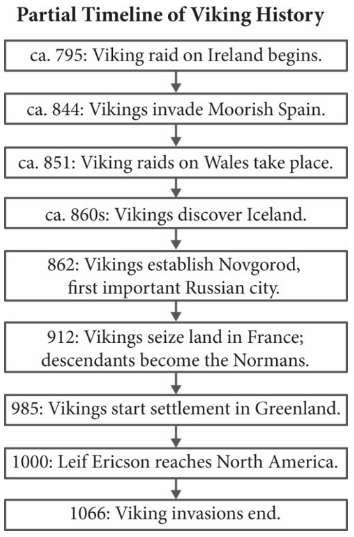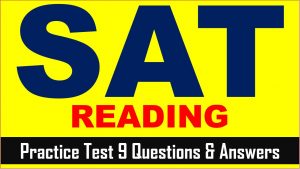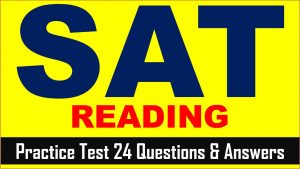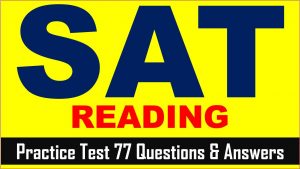Hi SAT Aspirants, welcome to AKVTutorials. As you know SAT (Scholastic Assessment Test) is a standard test, used for taking admission to undergraduate programs of universities or colleges of United States. SAT is developed and published by the College Board, an organization in United States, administered by the Educational Testing Service. Are you searching for SAT Reading Practice Questions? Then, in this article of AKVTutorials, you will get SAT Reading Prep Test 57 | SAT 2024 Online Course AMBiPi.
SAT Reading Practice Passage
SAT Reading Practice Test Comprehensive Passage
Passage 1:
| At the end of the eighth century, the |
|
| Scandinavians known as the Vikings took to the |
|
| seas, traveling to areas including Iceland, Greenland, |
|
| England, Ireland, France, and Russia, and even reach- |
|
| Line 5 | ing the shores of America some 500 years before |
| Columbus. The Vikings’ innovations in shipbuilding |
|
| were central to constructing their empire. They relied | |
| on the superior ships conjured in the minds of master | |
| shipwrights for travel and exploration. Using vessels | |
| Line 10 | such as the longboat, these fascinating seafarers |
| opened up new connections. The great longboat itself |
|
| attests to their outstanding maritime skills. |
|
| Before archaeologists discovered ships buried in |
|
| the muck of Danish fjords, Viking travel was a mys- |
|
| Line 15 | tery, but ship reconstruction has provided some |
| answers. Their ships were designed and built with |
|
| uncommon ingenuity to serve the Vikings’ purpos- | |
| es. The secret of the signature Viking ship is found |
|
| in its unique construction. The invention of the |
|
| Line 20 | longboat meant Vikings could travel vast distances |
| over treacherous open water. In contrast to modern |
|
| sailboats, the longboat was riveted together with |
|
| enough spacing so that the boat was flexible. |
|
| It could bend as it rode over waves instead of taking |
|
| Line 25 | the full impact of a swell. Incredibly, simple tools |
| such as axes, hammers, and scrapers were all that |
|
| carpenters used to frame a ship. |
|
| Additionally, the sleek longboat was an exceed- |
|
| ingly streamlined vessel. One kind of longboat |
|
| Line 30 | could ride high by skimming the waves to swiftly |
| transport a crew of about 30. This fast ship had a |
|
| draft of as little as 20 inches, allowing navigation in |
|
| extremely shallow water. |
|
| While its shallow draft and ease of construction |
|
| Line 35 | made the Viking longboat a superior seafaring vessel, |
| the seamanship of the Norsemen was the most deci- |
|
| sive factor in the success of their boats. For example, |
|
| Vikings navigated by looking at the sky through |
|
| a crystal, which was known as a sunstone. The |
|
| Line 40 | composition of the crystal was recently identified as |
| a transparent calcite common in Iceland. |
|
| The Vikings’ outstanding talents in ship con- |
|
| struction, coupled with their superlative skills as |
|
| navigators, greatly impacted Scandinavia. In turn, |
|
| Line 45 | through their explorations, the Vikings influenced |
| the rest of the world |
Passage 2:
| The Gokstad ship was excavated in 1880 and |
|
| dates to around AD 890; discovery of this Viking |
|
| ship revealed innovations in construction. Aptly |
|
| Line 50 | named “longboats,” such ships were long and |
| narrow and could travel on the open sea as well as |
|
| along rivers. The Gokstad ship is considered the |
|
| best preserved of the Viking longboats. It reveals |
|
| the technical achievements of the Vikings because |
|
| Line 55 | the shape was different from the norm. |
| The Gokstad ship owes nothing to earlier boat |
|
| designs, including those of the Egyptians and |
|
| Romans. The longboat was developed specifically |
|
| for Arctic waters. Its shallow draft, plus its ability to |
|
| Line 60 | change direction quickly, was a tremendous asset to |
| the Vikings. The Gokstad ship is 78 feet long with |
|
| two high, pointed ends. Constructed out of sturdy |
|
| oak, it features a low freeboard and is therefore |
|
| fast, the kind of ship used to carry Vikings on raids |
|
| Line 65 | across the North Sea. |
| The ship has been restored to reveal the Gok- |
|
| stad’s original shape. With holes for 16 oars |
|
| along each side of the ship, the crew would have |
|
| numbered about 34, counting 32 oarsmen plus a |
|
| Line 70 | steerman and lookout. Oars were typically 17 to |
| 19 feet long, constructed of pine with a narrow |
|
| blade that made each oar both efficient and light- |
|
| weight. In addition, the Gokstad features a mast |
|
| near the center that carried a large rectangular sail. |
|
| Line 75 | The Gokstad is different from earlier boat |
| designs in its planking, or framing out, as well; its |
|
| carvel planking made the ship watertight. Carvel |
|
| planking involves attaching wooden planks to a |
|
| frame and having the planks butt up edge to edge, |
|
| Line 80 | providing support from the frame and forming a |
| smooth surface. | |
| Contrary to popular belief, the Vikings were |
|
| not just warriors; they were also coastal farmers, |
|
| fishers, hunters, and craftsmen. Their lands were |
|
| Line 85 | harsh, however, and increases in their population |
| forced some men to search for other opportunities |
|
| Vikings, therefore, turned to trade and sea raiding. |
|
| Their swift sailing ships, already perfect for coastal |
|
| fishing, enabled Vikings to attack ports and towns, |
|
| Line 90 | making these seamen effective as both raiders and |
| traders. |
|
| Truly, the Gokstad ship is representative of a |
|
| great leap in seafaring, for this finest expression of |
|
| technical achievement could serve many purposes. |
|
| Line 95 | In 1982, its swiftness and seaworthiness was proven |
| when a copy, the Hjemkomst, journeyed from the | |
| United States to Norway. |

SAT Reading Comprehension Practice Test Questions
SAT Reading Practice Test Question No 1
The central idea of Passage 1 is that Vikings
Option A : excelled at shipbuilding and navigation.
Option B : had a passion for global exploration.
Option C : helped map the known world of their time.
Option D : led European peoples in technological innovation.
SAT Practice Test Answer No 1
Show/Hide Answer
Option A : excelled at shipbuilding and navigation.
Passage 1 explores the shipbuilding abilities and the navigation skills of the Vikings. It discusses how these skills enabled the Vikings to travel, explore, and extend their civilization, but the central idea is that the Vikings had exceptional abilities in shipbuilding and navigation.
SAT Reading Practice Test Question No 2
The introductory paragraph of Passage 1 most strongly suggests that which of the following is true?
Option A : The Vikings depended on sea trade and fishing to survive.
Option B : The Vikings expanded cultural interactions through seafaring.
Option C : The Vikings relied on colonization to support a growing population.
Option D : The Vikings sustained their economic development through sea raids.
SAT Practice Test Answer No 2
Show/Hide Answer
Option B : The Vikings expanded cultural interactions through seafaring.
In the first paragraph of Passage 1, the author suggests that the Vikings traveled far and wide, encountering other peoples and thereby engaging in cultural interactions. The concepts mentioned in the various answer choices, such as surviving via sea trade in A, supporting a growing population in C, and sustaining economic development through sea raids in D, are not supported in this paragraph.
SAT Reading Practice Test Question No 3
Which choice provides the best evidence for the answer to the previous question?
Option A : Lines 1-3 (“At the end … to the seas”)
Option B : Lines 7-9 (“They relied … exploration”)
Option C : Lines 9-11 (“Using vessels … connections”)
Option D : Lines 11-12 (“The great longboat … skills”)
SAT Practice Test Answer No 3
Show/Hide Answer
Option C : Lines 9-11 (“Using vessels … connections”)
Only (C) suggests the cultural interaction of the Vikings with other peoples through the phrase “opened up new connections.”
SAT Reading Practice Test Question No 4
The author of Passage 2 most likely chose to write about the Gokstad ship because it
Option A : contradicts prevailing beliefs about modern shipbuilding.
Option B : gives insight into various seafaring economic activities.
Option C : stands out as a unique example of early shipbuilding.
Option D : was a recent maritime archaeological discovery.
SAT Practice Test Answer No 4
Show/Hide Answer
Option C : stands out as a unique example of early shipbuilding.
SAT Reading Practice Test Question No 5
Passage 2 strongly suggests that the Vikings
Option A : adapted to their geography by moving often.
Option B : became seafarers to grow their civilization.
Option C : learned shipbuilding from other peoples.
Option D : used raiding as a means of livelihood.
SAT Practice Test Answer No 5
Show/Hide Answer
Option D : used raiding as a means of livelihood.
SAT Reading Practice Test Question No 6
Which choice provides the best evidence for the answer to the previous question?
Option A : Lines 56-58 (“The Gokstad … Romans”)
Option B : Lines 82-84 (“Contrary to … craftsmen”)
Option C : Lines 84-86 (“Their lands … opportunities”)
Option D : Lines 95-97 (“In 1982 … Norway”)
SAT Practice Test Answer No 6
Show/Hide Answer
Option C : Lines 84-86 (“Their lands … opportunities”)
Only lines 84-86 (“Their lands…opportunities”) explain the relationship between the geography and the economic needs of the Vikings and support the idea that the Vikings turned to sea raiding as an economic livelihood
SAT Reading Practice Test Question No 7
As used in line 93 of Passage 2, “expression” most nearly means
Option A : adaptation.
Option B : embodiment.
Option C : sentiment.
Option D : simplification.
SAT Practice Test Answer No 7
Show/Hide Answer
Option B : embodiment.
In the sentence, the author uses “expression” to show that the Gokstad embodies, or brings together, the best of Viking technical achievements.
SAT Reading Practice Test Question No 8
As used in line 29 of Passage 1, “streamlined” most nearly means
Option A : contoured.
Option B : efficient.
Option C : simplistic.
Option D : slight.
SAT Practice Test Answer No 8
Show/Hide Answer
Option B : efficient.
The author explains that the ship was able to ride high, skim the waves, swiftly transport a large crew, and navigate shallow waters. The implication is that the streamlined design affected the vessel’s performance, making it more efficient in a variety of seafaring situations.
SAT Reading Practice Test Question No 9
In lines 92-94 of Passage 2 (“Truly, the Gokstad … many purposes”), the author uses the phrase “a great leap” to emphasize.
Option A : the technological progress that Vikings made.
Option B : the distance that Vikings traveled.
Option C : the strong faith and traditions on which Vikings relied.
Option D : the widespread influence of Viking culture.
SAT Practice Test Answer No 9
Show/Hide Answer
Option A : the technological progress that Vikings made.
The author applies the phrase to seafaring and goes on to reference the technical achievements of the Vikings.
SAT Reading Practice Test Question No 10
Which generalization about the Vikings is supported by both passages?
Option A : Devoted to warfare, the Vikings built an empire that reshaped the map of Europe.
Option B : Innovations in shipbuilding and navigation saved the Vikings from decline and extinction.
Option C : The Vikings were noble warriors and farmers who sought to better understand the world.
Option D : Through their seafaring skills and abilities, the Vikings expanded and changed the world.
SAT Practice Test Answer No 10
Show/Hide Answer
Option D : Through their seafaring skills and abilities, the Vikings expanded and changed the world.
Both passages deal with the shipbuilding and navigation abilities of the Vikings, and both highlight how those abilities led to the expansion of Viking civilization beyond Scandinavia. This expansion had economic, social, and cultural impacts on other peoples.
SAT Reading Practice Test Question No 11
Which inference from the two passages is supported by the information in the timeline on page 100?
Option A : The Vikings endeavored to relocate surplus population through colonization.
Option B : The Vikings hoped to expand their cultural influence through economic exchange.
Option C : The Vikings traveled far and wide to launch sea raids and conduct trade.
Option D : The Vikings were compelled to abandon their homelands because of scarcity.
SAT Practice Test Answer No 11
Show/Hide Answer
Option C : The Vikings traveled far and wide to launch sea raids and conduct trade.
Several events in the timeline describe places that the Vikings “raided,” “invaded, “settled,” and so on. The passages both suggest that the Vikings used their seafaring skills to travel throughout Europe and across the Atlantic. Passage 2 specifically cites trade and sea raids.



